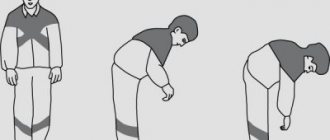Temperature from nerves - professional psychologists and neurologists are not surprised by this phenomenon. After all, the human body reacts sensitively to various processes occurring in the nervous system. You just have to strain yourself a little or overdo it with stress, and the body will respond with an increase in temperature. Clinical psychologist, neuropsychologist Irina Khvingia told AiF.ru about what thermoneurosis is, who is more susceptible to it than others and what consequences it can lead to .
The essence of the problem
There is no official diagnosis of “thermoneurosis” as such. But the phenomenon itself exists. Thermoneurosis is usually understood as a psychosomatic disease when a person experiences an increase in temperature over a long period. The numbers will be low-grade, that is, the temperature will fluctuate between 37-37.5 degrees. This is one of the manifestations of vegetative-vascular dystonia, and some experts even consider this state of affairs to be a sign of depression.
There are two types of thermoneuroses: psychogenic, which occurs against the background of stress, and neurogenic, when the brain is affected by hematomas, cysts and other formations that put pressure on the thermoregulation centers.
Article on the topic
Psychologist instead of antipyretics. How to calculate thermoneurosis?
If we are talking about a tumor, then we will have to be regularly examined and monitored. If the tumor does not grow, people live well with it for many years. In this case, it is usually recommended to undergo an MRI procedure once a year in order to monitor the condition of the formation in detail.
Temperature of a psychogenic nature can be elevated for a long time: from several days to several years. It all depends on who and how helps a person cope with the disorder. If everything is left to chance, the situation can be long-lasting.
We talk about thermoneurosis when the temperature remains unchanged throughout the day and for at least several days. For example, if it always stands at 37.2 or 37.3. To exclude factors influencing temperature and determine a more accurate diagnosis, it is recommended to draw up a temperature chart. Indicators must be measured three times a day. The first time is 20-30 minutes after sleep. There is no need to do it right away, without getting out of bed, because after waking up, everyone’s temperature is slightly elevated. Then measurements are taken during the day without reference to meals. And the third dimension is before bed.
Vegetative-vascular dystonia - a disease or a myth? More details
When is an increase in temperature dangerous?
High body temperature is an undoubted sign that some pathological process, usually of an inflammatory nature, is developing in the body. The higher the temperature, the faster it rises or the longer it lasts, the more serious the problem that caused it may be. This is why high temperatures are scary.
Meanwhile, in itself, an increase in temperature in most cases is a protective reaction to the penetration of infection. At high temperatures, the activity of pathogenic microorganisms decreases, and the body’s defenses, on the contrary, intensify: metabolism and blood circulation accelerate, and antibodies are released faster. But this increases the load on many organs and systems: cardiovascular, respiratory. High temperature depresses the nervous system and leads to dehydration. Possible circulatory disorders in internal organs (due to increased viscosity and blood clotting). Therefore, a high temperature that lasts for a long time can pose a danger in itself. Extremely high temperatures (above 41°C) are also dangerous.
Who is susceptible
The psychogenic option is more of a topic for teenagers and older people. After all, the loads are growing. For example, for children this means increased responsibility at school. A large number of classes, additional clubs and sections. Normal overwork occurs, the body cannot stand it and produces such a reaction.
This condition is typical for people with a hysterical personality type, those who are susceptible to hypochondria, suspiciousness, and those who are prone to various types of psychosomatics. Because they are the first to react to stress, and an increase in body temperature is the simplest reaction.
Frequently asked questions
Is it true that if a person has been in a state of nervous tension for a long time, he becomes more susceptible to various diseases? Can a nervous condition lead to illness?
Doctors' observations say that an initially mentally and physically healthy person is able to endure prolonged or severe stress without subsequent complications in the form of illnesses.
But if the body already has its own “weak points” in the form of a predisposition to diseases, disorders in the early (not yet identified) stages, or is weakened by a disease, then overstrain of the nervous system can trigger a whole cascade of ailments. Frequent examples of such developments are the formation of hypertension, weight loss or gain after stressful events.
Is it true that all “diseases are from nerves”?
Many diseases have causes and mechanisms of development in the form of disorders of the nervous system and psyche. But it is not correct to say that “all diseases are from nerves.” There are other causes for diseases: genetic defects, infections and poisonings, injuries, there are many disorders with an undetected etiology.
Can internal diseases cause mental disorders?
Yes. Body and psyche are connected. A significant part of diseases of internal organs can contribute to behavioral disorders and lead to mental illness.
For example, atherosclerosis and hypertension, if left untreated and progressing, will cause encephalopathy and psychoorganic syndrome (decreased memory, intelligence, emotional instability). Insufficiency of the thyroid gland leads to a decrease in intellectual capabilities.
Consequences of the problem
Thermoneurosis, which lasts for a long time, affects human health. And it doesn’t matter whether the body is a child’s or an adult’s. Children, as a rule, become irritable against its background. And adults become exhausted faster. Naturally, all this affects performance, because there is constantly not enough strength. At a constantly elevated temperature, the body requires more strength to concentrate attention and memory.
There are even more serious situations when symptoms such as fainting, arrhythmias, headaches, and sometimes insomnia appear. But still, for the most part, thermoneurosis is asymptomatic, accompanied only by fever and irritability. Against this background, the quality of life significantly decreases.
Temperature record. How to deal with high numbers on a thermometer Read more
Signs of a high fever
The following signs (symptoms) may indicate that the temperature is rising:
- a feeling of weakness, sudden fatigue, a general painful state;
- chills (mild chills at slightly elevated temperatures and severe chills at high temperatures);
- dry skin and lips;
- headache, body aches;
- loss of appetite;
- sweating (“breaks into a sweat”);
- arrhythmia.
If you are experiencing any of these symptoms, it would be a good idea to take a thermometer.
High temperature in a child
The child will not say that he has a high temperature. Even relatively older children, including students in elementary school, as a rule, cannot correctly assess their well-being. Therefore, parents need to closely monitor the child’s condition. You can suspect an increase in temperature based on the following signs:
- the child becomes unexpectedly lethargic or, conversely, restless and capricious;
- he is tormented by thirst (he asks for a drink all the time);
- mucous membranes become dry (dry lips, tongue);
- bright blush or, conversely, unusual pallor;
- eyes become red or shiny;
- the child is sweating;
- pulse and breathing increase. The normal heart rate is 100-130 beats per minute while sleeping and 140-160 while awake. By two years, the frequency decreases to 100-140 beats per minute. The normal breathing rate also depends on age; for a two-month-old child it is 35-48 breaths per minute, for an age from one to three 28-35 breaths.
You can measure body temperature in the armpit or groin cavity with a mercury thermometer (it most accurately shows the temperature), rectally - only with an electronic one. It is possible to measure the temperature rectally only in a small child (up to 4-5 months); older children resist the procedure, as it is unpleasant. To measure the temperature rectally, the tip of the thermometer is lubricated with baby cream, the child’s legs rise, as if washing. The tip of the thermometer is inserted into the rectum to a depth of 2 cm.
We should not forget that in children under one year of age, a normal temperature is considered to be a temperature of up to 37.5°C, and even up to 3 years of age, such a temperature does not always mean that the child is sick. You cannot measure the temperature when the child is very worried, crying, or is tightly wrapped up - the temperature in these cases will be expected to be higher. A hot bath or too high a room temperature can also increase your body temperature.
In young children, the temperature can rise up to 38.3°C for reasons unrelated to illness, such as:
- overheating (due to excessive wrapping, exposure to direct sunlight or poor drinking habits), especially before the age of 3 months;
- scream;
- constipation (if the child pushes, the temperature may rise);
- teething (one of the most common causes).
If it does not seem that the temperature is caused by one of these reasons, it persists and does not subside, or, moreover, increases, it is necessary to urgently consult a doctor. If the temperature is above 38°C, you should consult a doctor in any case.
Reduced body temperature
Like high temperatures, low temperatures also indicate problems. Especially if it lasts for a long time. This leads to rapid fatigue, loss of mood, weakness of the body, etc.
Causes of low body temperature
A decrease in temperature is observed:
- with low hemoglobin;
- in case of internal bleeding;
- during pregnancy;
- if there are problems with blood vessels;
- for diabetes;
- with pathology of the adrenal glands;
- during brain tumors;
- with asthenic syndrome;
- during skin lesions;
- as a result of seasonal ARVI;
- in case of intoxication;
- as a consequence of hypothermia;
- with hypothermia.
Symptoms of low body temperature
Symptoms include:
- weakness;
- drowsiness;
- apathy;
- chills;
- feeling of cold.
Should I lower the temperature or not?
There is no need to rush to lower the temperature. First of all, the patient must be examined by a doctor. You should follow the doctor’s recommendations: if he advises you to lower your temperature, then you should lower it. The doctor makes decisions based on the general picture of the disease and assessment of the patient’s condition, that is, recommendations are always individual.
However, if the patient has a severe fever and the temperature is high (39°C or higher), then he can be given an antipyretic drug, strictly following the instructions on the package. At the same time, you need to understand that you are fighting a symptom, not a disease.
The correct course of treatment involves identifying the cause of the high temperature and carrying out a set of measures aimed at treating the disease that caused its increase.
Thermoregulation in the body
For normal human life it is necessary that heat exchange be carried out constantly. It depends on the characteristics of the organism and on the presence of various reflex stimuli, and changes can have an effect even if the ambient temperature remains unchanged.
Violation of thermoregulation
First of all, such violations can occur as a result of exposure to external or internal factors. For example, internal diseases include various types of diseases.
The main symptoms can be considered:
- chills;
- chills, as a result of hyperkinesis - when involuntary muscle contractions occur;
- as a result of hypothermia - the consequences of hypothermia;
- as a consequence of hyperthermia - in case of overheating of the body.
The main causes of thermoregulation disorders are:
- congenital or acquired defect of the hypothalamus. It can negatively affect the functioning of many internal organs, including body temperature itself;
- climate change. This external factor is capable of influencing body temperature as a result of adaptation of the body;
- alcohol abuse;
- a consequence of processes associated with aging;
- various mental disorders.











